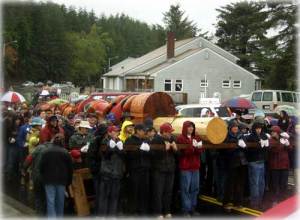A mountain of unavoidable boat projects caused a few days’ delay, but I’m now reasonably certain that the good ship Charity will pull out of Seattle’s Fisherman’s Terminal today. As certain as a deckhand ever can be, that is. If a profession rooted in taking life can offer Buddhist teachings, it’s this: Let go of expectations and attachment, as captains reserve – and continually exercise – the right to change plans.
(I have a ways to go yet on realizing this lesson.)
Had some excitement this week. If you read Hooked’s last post, you know I was pretty casual about packing for this trip. Saved it for my last night at home, tossed everything into a couple bags. I don’t expect to be on the Charity for more than a month, and the process is pretty formulaic. Boots, raingear, toiletries, a lot of fish clothes, a little of town clothes. (“Town clothes”: A T-shirt and Carhartts that haven’t been worn while fishing. That’s pretty classy for our crowd.)
While Martin did the Costco run, I prepared to gel-coat the head floor. At lunch, he’d said we’d likely stop in Bute Dale, a mystical ghost town several days into Canada. Century-old skeletons of houses and a long-abandoned cannery slide into the bay under the supervision of a massive waterfall and one lone caretaker, Lou.
My thoughts wandered as I wiped the floor down with acetone. Haven’t stopped in Bute Dale since the last time I fished with Martin…what, 6 years ago? Wonder what’s left of it. Bute Dale… Canada…Customs…Passport – NO PASSPORT!
I called Joel in panic-stricken disbelief. We were planning to leave in the next day, and not only had I forgotten to pack my required documentation for transiting through Canada, I didn’t have a clue where I’d put it. A bad surprise for anyone; extra mortifying for the family member known as the responsible, organized one.
Cap’n J saved the day. He calmed me down, refusing to play my “What if you can’t find it!” game. When he didn’t find it in any of my usual safe-keeping spots, he drove down to the Nerka, checked the binder of required documents on our boat. No dice. I jumped when the phone buzzed several hours later, and felt my shoulders sag when he said, “Found it.”
With that, things took a turn for the better. Joel had already planned a trip through Seattle for the next day, so he made a special delivery detour through Fisherman’s Terminal. We had a bonus last lunch together, a few more hugs and kisses goodbye, and I’m now legal to travel through Canada. Whew.
We got fuel yesterday. Over $3500 of diesel. That’ll get us to Alaska; we’ll have to fuel up again in Sitka before we can go fishing. We’ve still got a few tasks today – groceries, running new anchor line on the winch, checking the survival suits. If you’d like to keep an eye on our trip, visit here and here for marine weather updates. We’ll be heading up the Inside Passage, Seattle to Sitka, and expect a 5 to 6 day trip, barring any weather-related delays.
When you next hear from the F/V Charity, we should be safely tethered to Sitka’s Eliason Harbor. If we pass on the dock, you’ll know me by the halibut-sized grin on my face. I’ll have made the first walk up to the Backdoor, Romeos fairly skipping over the sidewalk to get to that homecoming slice of Bernadette’s close-your-eyes-and-whimper-it’s-so-good pie. (See? So much for letting go of expectations.)
Until then, sweet reader, may you enjoy clear skies and safe seas in your life, as you embrace your own seasonal transitions.












